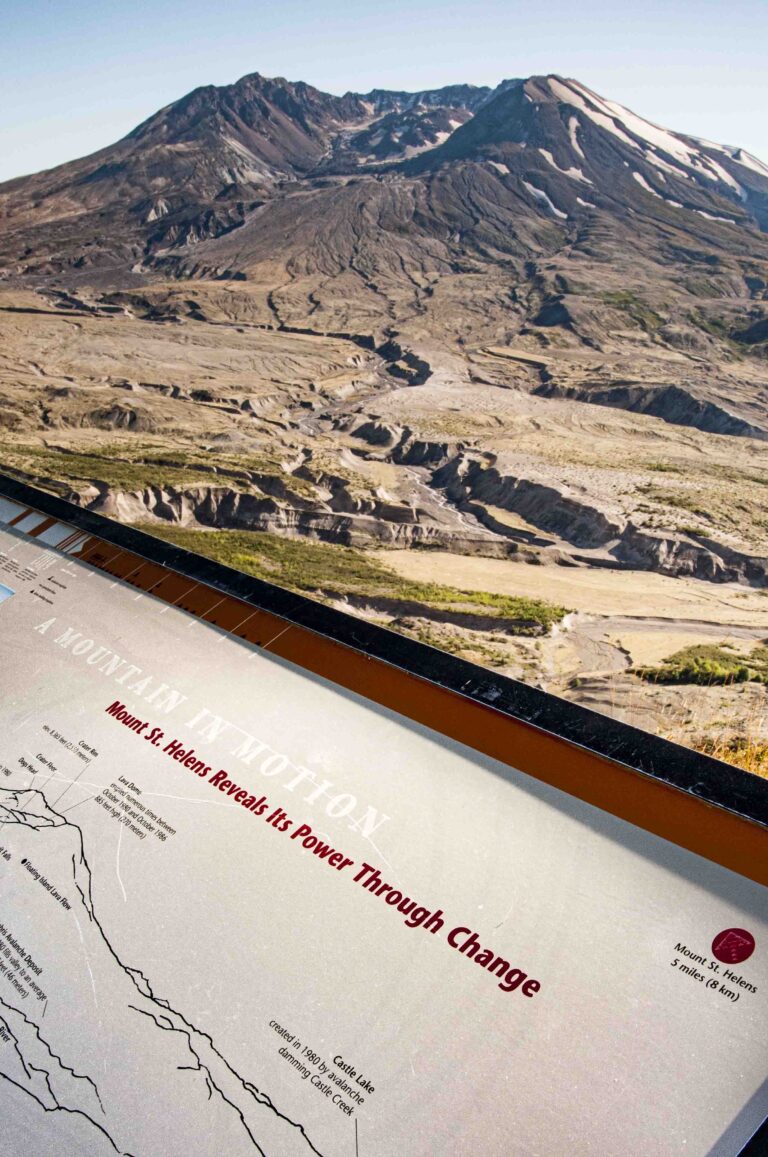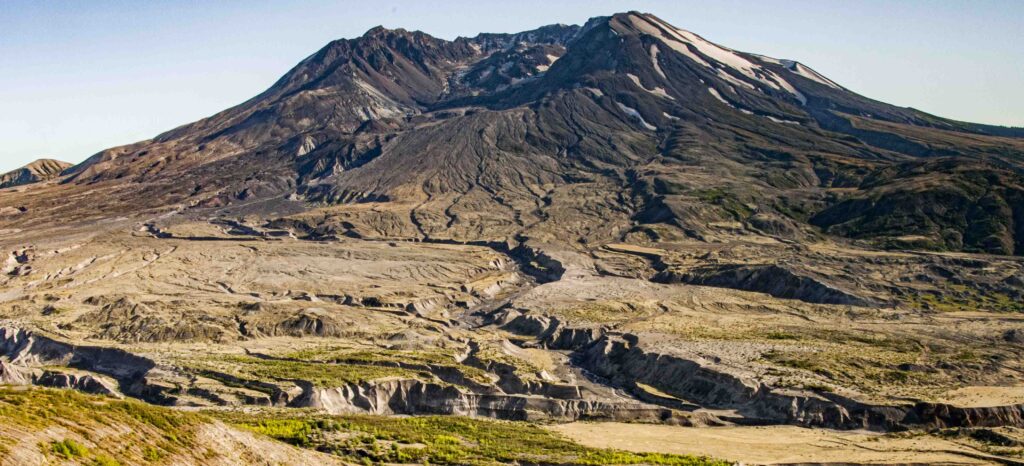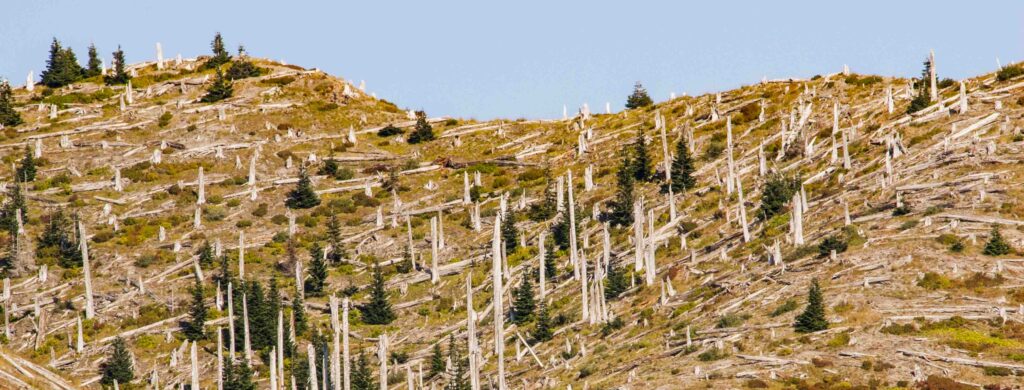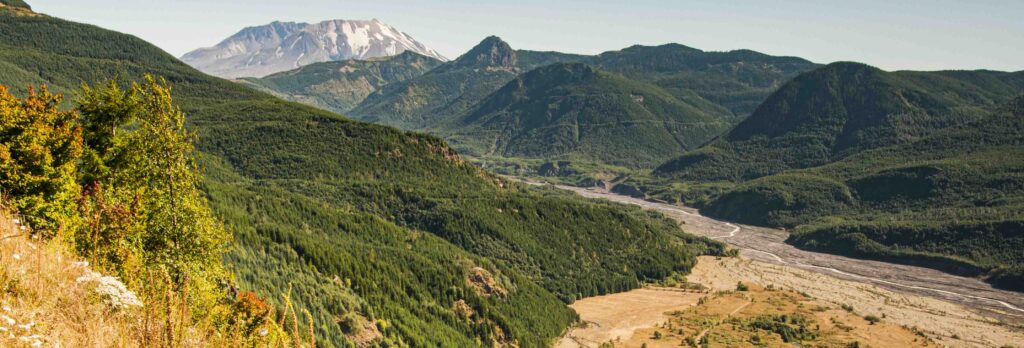Mount St. Helens & the Toutle River
Columbia River Basin
|
NEW ESRI StoryMaps: What's On Our Shelves & NWNL Song Library & No Water No Life ESRI |
Columbia River Basin
Norm Vader
Johnson Ridge Observatory Volunteer
Alison M. Jones
NWNL Director and Photographer
Remembering the predictions and vivid TV footage of Mount St. Helen’s eruptions on May 18, 1980, I visited that Cascade Range site in the Toutle River Basin. The Mount St. Helens Hoffstadt Bluffs Visitor Center and Norm Vader’s tour narration strongly underlined Nature’s twin roles of fire and water as an excavator and creator of habitats.
A USACE (Army Corps of Engineers) sign humorously described the still-moist sediment held by an upstream structure: “When you nudge it with your toe, it moves, but doesn’t break – kind of like the skin that forms on the top of pudding after it’s sat for a while.”
The scene I witnessed in 2011 had changed greatly since the 1980 eruption. Much of the shock and awe, as well as raw edges had weathered and softened. However the huge impacts are explained by excellent signage and tours that emphasis the continuity of change that our planet sustains – whether caused by fiery blasts or the quiet passage of time. This site is worth a visit any time.

NORM VADER’S NARRATIVE
THE ERUPTION
NATURE in RECOVERY
HUMAN HELP DIDN’T HELP
LEAVE MOTHER NATURE ALONE!
Key Quote The wild salmon in the Pacific “Ring of Fire” have evolved to repopulate themselves in watersheds devastated by volcanic eruptions, earthquakes, glaciers, landslides. They’ve been doing it successfully for millions of years. – Norm Vader
All images © Alison M. Jones, unless otherwise noted. All rights reserved.
To tourists gathered outside the Mount St. Helens Hoffstadt Bluffs Visitor Center
Yes, to those who have just asked if there are current conservation concerns regarding post-eruption damage to ecosystems downstream and downwind of Mount St. Helens. And yes, there are current and ongoing restoration efforts. For instance, many of us worry the sediment flowing from behind the dams will become too much for the salmon to overcome. We worry that natural recolonization might take too long and whether we need hatchery supplementation to help speed the recovery of salmon and other affected indigenous populations.
I will discuss these concerns; but I want to turn away from conservation concerns for just a moment and tell you a story about a river.

On May 18, 1980, Mount St. Helens erupted, sending a wall of super-heated volcanic ash into the Toutle River watershed. The result was complete and utter devastation of the river as tributaries from the main stem itself boiled under 1,000º temperatures. If you witnessed it, or if you’ve seen pictures of the aftermath, you know what I’m talking about. All that remained was a desert landscape of blown-down trees and thin trickles of muddy water running over vast stretches of gray ash fields. For all intents and purposes, the Toutle River was dead — or so we thought.
It turns out we underestimated Mother Nature’s ability to heal herself. Within 5 short years, wild steelhead were back in what was left of the Toutle River, finding ways to survive, reproduce and miraculously thrive. By 1987, there were 2,588 wild steelhead spawning here in the Toutle River, a number that far exceeded what biologists considered to be its carrying capacity, even before the eruption.
In contrast, that same year, the nearby Kalama River [a 45-mile Columbia River tributary, just south of Mt St Helens], which was completely untouched by the eruption and is supported by its high hatchery production, had a return of just 248 wild steelhead [i.e., 9.5% of the Toutle River’s total]. Somehow, within 7 years of complete obliteration, the Toutle River had more wild winter steelhead than any other river in the entire Columbia River Basin. It’s an amazing story.

Unfortunately, it doesn’t end there. When we saw those numbers in a river we’d written off for dead, we humans decided to help Mother Nature by resuming massive hatchery plans and building a sediment retention dam. The explosive growth of the Toutle’s new wild steelhead population responded to our “help” by stalling and eventually dwindling to match the low returns of all the other hatchery supplemented Columbia River tributaries.
This story shows us that wild fish can and will repopulate a barren river on their own and much faster than anyone ever imagined. It also shows us what happens when man tries to improve Mother Nature. Fortunately, there are pure genetic strains of sockeye and steelhead remaining above the dam; 100 miles of pristine habitat inside the national park; and plenty of opportunity for wild strays to repopulate the river from the Strait of Juan de Fuca.
The sediment load coming down from the dams will only affect the lower main stem of the Toutle River, leaving headwater and tributary spawning grounds untouched. The wild salmon in the Pacific “Ring of Fire” have evolved to repopulate themselves in watersheds devastated by volcanic eruptions, earthquakes, glaciers, landslides. They’ve been doing it successfully for millions of years.
But because we’ve somehow lost our faith in Mother Nature and won’t believe what science has shown us in places like the Toutle, we’re about to start releasing inbred, out-of-basin hatchery stocks into this newly restored habitat. Despite overwhelming evidence showing that the presence of hatchery fish is a powerful detriment to wild salmon recovery, we insist, once again, on “helping” the natural process.
My wish, as a fisherman and especially as the father of two young children, is that we could somehow find enough patience and faith to let Mother Nature do what she’s always done. Thank you for your time.

Posted by NWNL on April 18, 2024.
Transcription edited and condensed for clarity by Alison M. Jones.
All images © Alison M. Jones, unless otherwise noted. All rights reserved.
